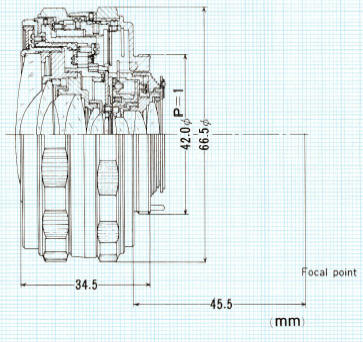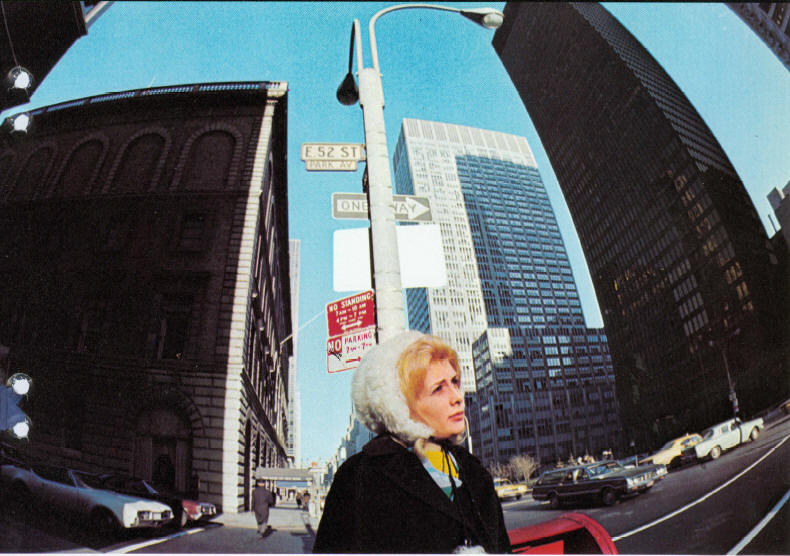|
|||||||
|
|||||||
Specifications

| Pentax Super-Takumar 17mm f/4.0 | |
| Minimum Aperture | f/22 |
| Lens Element | 4 |
| Diaphragm | Fully Automatic with depth of field preview setting Stop-down
metering on |
| Minimum Focusing Distance | 0.2 meters/0.66 feet |
| Angle of View | 180 degrees |
| Weight | 228 grams/8 ounces |
| Maximum diameter | 66.5mm |
| Length | 30mm |
| Filter Size | 3 built-in filters, Gelatin filter frame |
| Lens Cap Size | 60mm |

The magic world of the fish-eye lens
The 180· angle of the 17mm fish-eye lens gives you a new view of the world - you see things exactly as your lens sees them when you look through the viewfinder. And the maximum aperture of f4 makes this one of the world's brightest fish-eye lenses. It has the excellent resolution for which all Super-Takumar lenses are famous, and is equipped with a fully automatic diaphragm, and focuses through the viewfinder to as close as 20cm. Bring out the magic in photography with the Super-Takumar fish-eye.
Specifications | Construction | Infra-red Index | Fixed Focus Mark
Close this window to return to eBay
Features
This unique Takumar fish-eye lens lets you view the image in the focusing screen without keeping the mirror up. Its angle of view is a full 180° diagonally across the frame, and the fully automatic diaphragm opens up to f4, giving a bright focusing image right down to 20cm. The specially designed 11 lens elements in 7 groups eliminate all aberration except for the degree of distortion and give edge-to-edge sharpness even with the diaphragm fully open.
Three filters are built into the lens - UV, Y2, and O2 (056) - as well as an adaptor for a gelatin filter at the back of the lens, making this a high-performance fisheye lens that can hold its own in any company.
Main uses: The distortion and great depth of field make this a lens ideally _Suited for adding a fascinating new dimension to scenic images, Ordinary snapshots and commercial photography. Its fine color reproduction also recommends it to all color specialists.
Construction
Asahi Optical began manufacturing specialized lenses in 1919, and has been producing lenses for general photography since 1932, twenty years before the Pentax, the first SLR camera from Japan - was manufactured.
Painstaking hand craftsmanship, the highest quality raw materials and the most advanced technological know-how are combined in the manufacture of each Super-Takumar.
In the beginning, lens design required logarithmic tables, slide rules and great patience. It often took three competent designers several years of steady work to complete the computation of a single 4-element lens. Today, Asahi utilizes the most modern electronic computer equipment which performs extremely complicated calculations very rapidly and with great accuracy.(Photo shows back of lens with gelatin filter holder installed, and removed.)
Fine optics alone cannot make a superior lens; the mechanical components are equally important. Lens barrels of Super-Takumar lenses are precision machined for accurate positioning of all elements. Tolerances are so tight you have to break a vacuum to disassemble some elements. Each Super-Takumar has dust and moisture-proof seals and a special diaphragm damper that cuts down on wear, vibration and bounce so you get consistent aperture openings. (Photo shows lens with orange (left) and yellow (right) filters "dialed-in")
All mechanical components are precision machined to microscopic tolerances. Specially lubricated, wear-resistant metals assure consistently accurate apertures year after year. Screw mounts are the most precise method of holding a lens firmly in place. Perfectly matched threaded mountings on Takumars make changing lenses quick and easy - even in the dark. (Image shows a line-drawing of the Fisheye-Takumar lens - click to enlarge)
Specifications | Construction | Infra-red Index | Fixed Focus Mark
Close this window to return to eBay
Infra-Red Index
When taking infra-red photographs, the focal point shifts slightly, and therefore, the lens must be extended accordingly. The difference varies depending on the lens, and it is indicated by the small "R" index or short orange line. In infra-red photography, use this infra-red index. First, focus your lens on your subject. Determine the lens-to-subject distance from the distance scale. Then match your "R" mark by turning the distance scale accordingly. Like the photo to the left, if your subject is in focus at infinity, turn the distance ring and move infinity mark to the "R" index. Also, remember to use an R2 (red) or O2 (orange) filter (built-in) and special infra-red film in this special photography.
Specifications | Construction | Infra-red Index | Fixed Focus Mark
Close this window to return to eBay
Fixed Focus Mark
Since wide-angle lenses have a great depth of field, they are suited for snapshots. To obtain maximum depth of field, convenient marks have been included on the Takumar wide-angle lenses. They are shown in red figures on the diaphragm and distance scales. If you set these figures to the index, you do not have to turn the focusing ring every time you want to take a snapshot. The photo at the left indicates that the lens diaphragm is set to F8 and the distance scale is set at 4 feet, both figures being the fixed-focus marks. read the depth-of-field guide, and you will see that this setting affords a depth of field from about 2 meters to infinity; within this field everything will be in focus. Setting the aperture to f/22 and aligning the infinity mark to the 22 index yields depth of field from infinity to about 9 inches! However, even without using the fixed focus mark, it is possible to make extremely efficient judgments about depth of field by checking it on the scale which shows the relation between distance setting and aperture.
Note: CAMERA NOT INCLUDED - SHOWN for Illustrative Purposes ONLY
Specifications | Construction | Infra-red Index | Fixed-Focus MarkClose this window to return to eBay
| Photos,
Layout and Design © 2009 Paul M. Provencher All
Rights Reserved. Contents of this Web Site may not be used without written permission. |
Visits since 10/3/2009